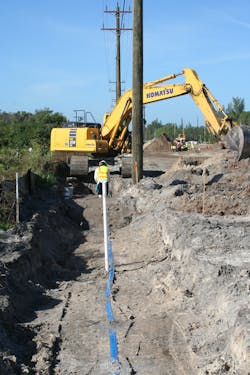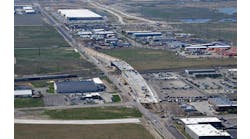By Jim Forbes, Contributing Author
Roadway and bridge construction projects can be challenging. But also having to relocate existing utilities out of the way of these projects prior to the start of construction can add a whole new dimension to the challenges. These utilities can include water and sewer mains, electrical conduit, natural gas lines, fiber optic cables, and others.
More than 90% of America’s highways were constructed before 1950, and the need to repair and widen the roadways runs headlong into all the utility infrastructure, according to one estimate from the Federal Highway Administration.
In addition, a 2022 U.S. Federal Transit Administration white paper on the challenges and proposed solutions to utility relocation states that developing “an effective plan to manage utility relocations on any project is critical to the overall project success. Utility relocation can become one of the greatest risk factors to the schedule and cost of transit projects.”
As an example of the problems this can lead to, one state transportation department was unable to start over 50% of its projects on time because utility relocations had not been completed. Some smaller utility companies do not have enough staff members, or even the budget, to do the designs and field work to relocate their existing facilities, causing delays in projects that are otherwise ready to proceed.
This article will explore some of the more common challenges and potential solutions associated with utility coordination for the construction of roadway and bridge projects. Knowing about and preparing for these challenges ahead of time can help prevent or at least minimize costly project delays.
Safety
Accidentally striking buried utilities during construction activities is one of the most common jobsite hazards, and it can cause the interruption of services to nearby residential or commercial customers. However, if associated with a natural gas line or electrical conduit, it can also potentially result in serious injury or even death.
Safety risks to contractors or other utility personnel can also include the release of hazardous material like natural gas into the environment. Antiquated materials including asbestos pipes or conduits, or leaking fuel tanks, require special environmental handling and permitting for removal and disposal. If handled improperly, they can present potential health risks to the utility or construction personnel and the public.
Service disruption to customers
In addition to the safety risks associated with striking buried utilities, it can also cause the disruption of service to the utility’s paying customer base and a resulting loss of revenue. This compounds the direct cost of the relocation project itself and unnecessarily tests public trust and relationships.
When buried utilities are damaged, temporary utilities may have to be installed to not only allow for the continuation of service to customers but to also allow for the start of the construction project itself. The negative impacts to the project’s cost and schedule in this instance can be enormous. Also, there is the old adage that there are no such thing as “temporary” utilities—all utilities are installed as if they are to be permanent. Even temporary utilities are expensive.
Working with multiple utilities in the same corridor
Particularly in urban areas, underground utilities can often occupy a lot of space in tight corridors. One issue faced with the identification of existing utilities is that some private utilities may not be part of a location request to 811, so these utilities need to be verified before utility relocations begin. Also, telecommunications firms often share conduits in tight corridors but not all of them “play nice in the sandbox,” since many do not like for their competitors to know where their lines are located or what facilities they have installed.
Compounding the issue is that many utility companies often simply abandon their outdated facilities rather than removing them due to the costs involved. This adds to contractors’ frustration because they do not know if these utilities are active or dead. One solution that has helped with identifying abandoned utilities is that more and more DOTs are requiring all utilities to have tracer wire connected to the conduits that the utilities are placed in.
In the past, the only underground utilities that were somewhat traceable were old power and telephone lines. Old PVC water and gas lines were not required to have any way to trace or identify their facilities. It is not difficult to see how this could easily become a safety issue by not knowing whether these lines were still active.
Also, as alluded to earlier, most utilities must pay for their own relocations, unless prior rights have been shown or proven. Prior rights can be either proven by an affidavit from the utility company or historical documentation of when the utility was installed, which can include as-builts or photographs from that time period.
Permitting
The permitting process for utility relocation projects can often take anywhere from six to 12 months and can have serious impacts on the overall construction schedule, so this needs to be built in from the beginning.
For example, the permits to cross railroad tracks can cost a utility tens of thousands of dollars. It has been such a problem in the past that in some cases, telecommunications firms have placed moratoriums on such crossings because of legal issues associated with the railroad permitting process.
Environmental permits can also represent potentially serious schedule setbacks to utility relocation projects since their intent is to minimize or prevent environmental impacts to nearby wetlands, other sensitive receptors, or buffers zones surrounding these areas.
Schedule
Utility relocation almost always impacts the schedule of roadway and bridge construction projects. Utility easements must be acquired by either the state or local municipalities doing the roadway or bridge construction. This is usually for wet utilities as well as power, but also frequently for gas utilities. Acquiring multiple parcels for easements within a project corridor can take anywhere from nine to 12 months, especially if the condemnation of land must occur.
Missed or abandoned utilities may impact the construction schedule due to delayed utility relocations impacting the construction Let Date. It must also be noted that not all buried utilities are accounted for because they are simply not able to be located due to poor record keeping and undocumented past relocations. Also, abandoned utilities found during construction will make the roadway contractor stop work until it has been confirmed that each utility is no longer in danger of being damaged or a safety hazard to the construction crews. These delays can impact a project schedule, especially if there are multiple abandoned utilities in the same location.
Potential Solutions
With the trials and tribulations of utility relocations, DOTs need to look at other possible solutions for relocating the utilities in a timely manner while keeping costs under control.
One potential solution, particularly for larger projects where there are multiple underground utilities that need to be relocated, is to construct a conduit-encased duct bank. Joint costs can be shared between the multiple utilities and/or the DOT, while only one contractor would be needed to install it. This would allow the utilities to have a defined pathway while allowing the DOTs and municipalities to know where all the utilities are located.
The conduits could be labeled or color coded for each utility to identify the location for their facilities. This would also reduce the time for the relocations by having just one contractor install the duct bank instead of each utility having their own contractor install each underground utility. The associated cost sharing would reduce the overall expense for each relocated utility and keep costs down for smaller utilities with limited financial resources. Also, if the states were to dedicate a corridor for the utilities, whether in a duct bank or not, this would pave the way for the relocation of current utilities for a particular project and for utilities to come through in the future, allowing the DOT to dictate where they must go.
Another solution, though not popular with state agencies, is to incorporate the relocation cost for all utilities into the project cost. This would allow the smaller companies to devote more personnel to the project, which in turn would help keep the project on schedule. Some small telecommunications firms, for example, only have one engineer to cover multiple counties and these projects are sometimes in very rural areas where the states are expanding and replacing multiple highways and bridges.
Remember, utilities are interested in making money from paying customers, not spending money, which is what happens when they must install new utilities or relocate their existing facilities due to roadway improvement projects.
The solutions to the challenges described in this article are not easy or quick – or even cheap. They will require close coordination between federal, state, local, and private entities over many years and will involve these parties being able to cooperatively work towards a common goal, which is not always easy. But the costs associated with simply maintaining the status quo are far greater and will require visionary forward thinking. R&B
Jim Forbes is a Senior Project Manager for Weston & Sampson in Apex, North Carolina. He has 10 years of experience in transportation-related utility relocation coordination and design, as well over 35 years in civil construction and design.



